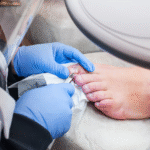
Podiatry Solutions for Bunions and Ingrown Toenails
September 26, 2025
https :// : thehometrotters.com – our Guide to Home Decor
September 29, 2025
Foot injuries are common and can happen to anyone, whether you’re an athlete, a busy professional, or someone who enjoys walking and outdoor activities. While some foot injuries are minor and heal on their own, others require professional attention to prevent long-term problems. Understanding when to visit a podiatrist for foot injuries can save you from prolonged pain, improper healing, or even chronic conditions.
What Is a Podiatrist?
A podiatrist is a medical professional specializing in the diagnosis, treatment, and prevention of foot, ankle, and lower leg conditions. Unlike general practitioners, podiatrists have specialized training to treat injuries ranging from minor sprains to serious fractures, as well as chronic conditions such as plantar fasciitis or bunions. Visiting a podiatrist ensures that your foot receives the proper care and recovery plan tailored to your injury.
Common Types of Foot Injuries
Foot injuries can vary widely in severity and type. Some common foot injuries include:
- Sprains and Strains – Occur when ligaments or muscles are overstretched or torn, often during physical activity.
- Fractures – Broken bones in the foot or toes can result from falls, accidents, or repetitive stress.
- Heel Pain and Plantar Fasciitis – Inflammation of the tissue connecting the heel to the toes, often caused by overuse or poor footwear.
- Toenail Injuries – Includes ingrown toenails, bruised nails, or infections that cause pain and discomfort.
- Cuts, Burns, and Blisters – Minor injuries that can worsen if infected or not treated properly.
Signs You Should See a Podiatrist
While minor foot pain can sometimes be managed at home, there are certain signs that indicate the need for professional evaluation. Here are the key warning signs:
1. Persistent Pain or Swelling
If your foot pain lasts more than a few days or keeps coming back despite rest and over-the-counter pain relief, it’s a good idea to consult a podiatrist. Persistent swelling can signal a fracture, ligament injury, or chronic condition that needs professional treatment.
2. Difficulty Walking or Bearing Weight
Any injury that makes it hard to walk or put weight on your foot should be examined immediately. Limping or avoiding using the affected foot may cause further complications if not treated.
3. Deformity or Visible Abnormalities
If your foot or toes appear misshapen, swollen, or misaligned after an injury, it could indicate a fracture or dislocation. Early intervention by a podiatrist can prevent permanent damage.
4. Numbness or Tingling
Numbness, tingling, or a burning sensation can be a sign of nerve damage or circulation problems. Podiatrists can assess the cause and recommend appropriate treatment to prevent worsening symptoms.
5. Signs of Infection
Cuts, blisters, or toenail injuries that show redness, warmth, pus, or increased pain may indicate an infection. A podiatrist can provide proper wound care and prescribe antibiotics if necessary.
When to Seek Immediate Medical Attention
Some foot injuries require urgent care rather than a routine podiatrist visit. Seek immediate help if you experience:
- Severe pain after trauma or an accident
- Bone protruding through the skin
- Inability to move the foot or toes
- Significant bleeding that doesn’t stop
- Signs of severe infection (fever, spreading redness, or pus)
In these cases, visiting an emergency room first is recommended, followed by a podiatrist for specialized care.
How a Podiatrist Diagnoses Foot Injuries
When you visit a podiatrist, they may use several methods to diagnose your injury:
- Physical Examination – Assessing range of motion, swelling, and pain areas.
- Imaging Tests – X-rays, MRI, or CT scans to detect fractures, soft tissue injuries, or structural issues.
- Gait Analysis – Evaluating how you walk to identify alignment or movement problems.
- Medical History Review – Understanding previous injuries or underlying conditions that may affect recovery.
Treatment Options Offered by a Podiatrist
Treatment depends on the type and severity of the injury. Common approaches include:
- Rest, Ice, Compression, Elevation (RICE) – Standard care for minor sprains and strains.
- Orthotics or Braces – To support injured or weak areas of the foot.
- Physical Therapy – Strengthening exercises to restore mobility and prevent future injuries.
- Medications – Pain relievers, anti-inflammatories, or antibiotics for infections.
- Surgery – In severe cases such as fractures, dislocations, or chronic conditions unresponsive to conservative treatments.
Preventing Foot Injuries
While accidents can’t always be avoided, you can take steps to protect your feet:
- Wear proper footwear that provides support for your activity.
- Warm up before exercise and stretch regularly.
- Avoid overtraining or sudden increases in activity intensity.
- Keep your nails trimmed and practice good foot hygiene.
- Address minor foot pain promptly to prevent worsening.
Conclusion
Knowing when to visit a podiatrist for foot injuries is crucial for proper healing and preventing long-term complications. Persistent pain, swelling, difficulty walking, deformities, and signs of infection are all indicators that professional care is needed. By seeking timely treatment, following your podiatrist’s guidance, and taking preventive measures, you can maintain healthy and pain-free feet.
FAQs About Visiting a Podiatrist for Foot Injuries
1. How soon should I see a podiatrist after a foot injury?
Ideally, if pain, swelling, or difficulty walking persists for more than 48–72 hours, you should schedule an appointment.
2. Can a podiatrist treat fractures?
Yes, podiatrists can diagnose and treat fractures, including providing splints, casts, or surgical interventions if needed.
3. Are podiatrist visits covered by insurance?
Most health insurance plans cover visits for foot injuries, especially if deemed medically necessary. Always check with your provider.
4. Can foot injuries heal without a podiatrist?
Minor injuries may heal on their own, but untreated or severe injuries can lead to chronic pain, deformities, or mobility issues.
5. What should I bring to my first podiatrist appointment?
Bring your medical history, a list of current medications, details about the injury, and any imaging or test results if available.

